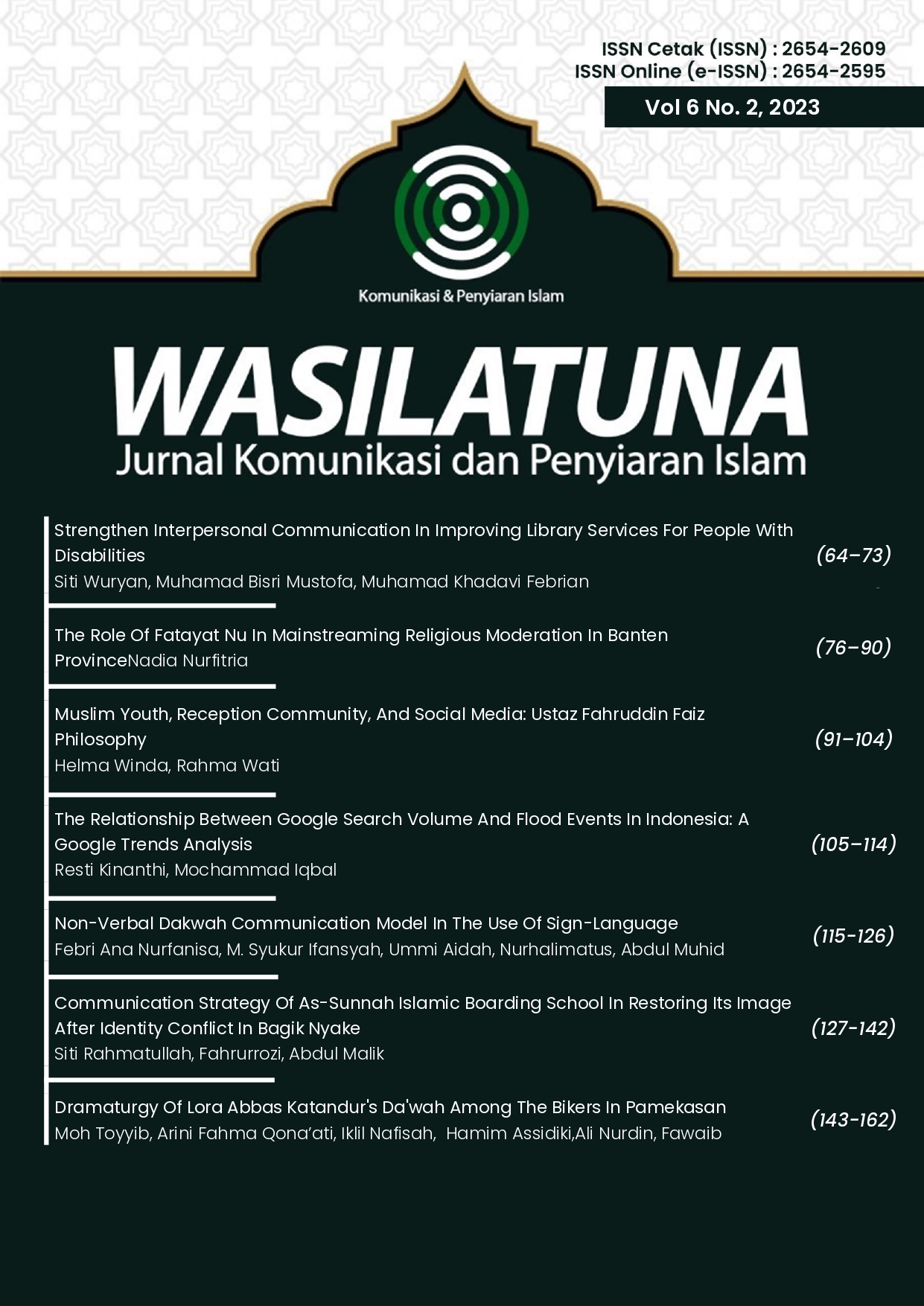THE RELATIONSHIP BETWEEN GOOGLE SEARCH VOLUME AND FLOOD EVENTS IN INDONESIA: A GOOGLE TRENDS ANALYSIS
DOI:
https://doi.org/10.38073/wasilatuna.v6i02.1014Keywords:
Flood, Disaster Risk Communication, Google TrendsAbstract
The increasing number of floods every year brings a wide impact; the average loss caused by floods every year reaches 4.64T (Rp). Information about floods is very important to improve the preparedness of people living in disaster-prone areas. If information can be provided when people have a high interest in learning, it can have a profound effect on increasing public knowledge. To carry out effective risk communication in flood disasters, knowledge about flood disaster patterns is needed, as well as knowledge about community behavior in seeking information. One of the people's behavior in searching for information can be seen from the Google Trends analysis. The purposes of this study are to analyse the relationship between public interest in finding information through google trends with the keyword "flood" with flood events in Indonesia for 10 years. This research is a quantitative descriptive study by processing data obtained from Google Trends and BNPB flood event data using the Spearman Rank Correlation statistical test with SPSS software. The results showed that Google Trends with the keyword "Flood" and the pattern of flood events had a strong positive relationship with a correlation coefficient of 0.64, this indicates that the increase in the incidence of disasters causes an increase in public interest in seeking information about flood disasters. Risk communication that was carried out before the disaster occurred was not yet optimal in reaching the community. Risk communication needs to be carried out before the months that are predicted to be the peak of flood events. Risk communication is carried out to form the preparedness of the Indonesian people so that the risk of flood disasters can be reduced.Downloads
References
Alcántara-Ayala, Irasema, and Ana Rosa Moreno. 2016. “Landslide Risk Perception and Communication for Disaster Risk Management in Mountain Areas of Developing Countries: A Mexican Foretaste.” Journal of Mountain Science 13 (12): 2079–93. https://doi.org/10.1007/s11629-015-3823-0.
Asteria, D. 2016. “Optimalisasi Komunikasi Bencana di Media Massa sebagai Pendukung Manajemen Bencana.” Jakarta. http://www.penanggulangankrisis.depkes.go.id/.
Bakshy, Eytan, Itamar Rosenn, Cameron Marlow, and Lada Adamic. 2012. “The Role of Social Networks in Information Diffusion.” In WWW’12 - Proceedings of the 21st Annual Conference on World Wide Web, 519–28. https://doi.org/10.1145/2187836.2187907.
BNPB. (2020). Data & Informasi Bencana Indonesia. (Online). https://dibi.bnpb.go.id. 7 April 2022
Effenberger, Maria, Andreas Kronbichler, Jae Il Shin, Gert Mayer, Herbert Tilg, and Paul Perco. 2020. “Association of the COVID-19 Pandemic with Internet Search Volumes: A Google TrendsTM Analysis.” International Journal of Infectious Diseases. Elsevier B.V. https://doi.org/10.1016/j.ijid.2020.04.033.
Google. (2022). Google Trends Help, in, Google Inc. https://support.google.com/trends/answer/4365533?hl=ko&ref_topic=6248052
Kaatz, Martin, Steffen Springer, Roger Schubert, and Michael Zieger. 2022. “Representation of Long COVID Syndrome in the Awareness of the Population Is Revealed by Google Trends Analysis.” Brain, Behavior, & Immunity - Health 22 (July): 100455. https://doi.org/10.1016/j.bbih.2022.100455.
Kebijakan, Badan, and Fiskal Kementerian Keuangan. 2018. Strategi Pembiayaan Dan Asuransi Risiko Bencana.
Khoury, Muin J., and John P.A. Ioannidis. 2014. “Big Data Meets Public Health.” Science. American Association for the Advancement of Science. https://doi.org/10.1126/science.aaa2709.
Linkov, Faina, Ali Ardalan, Meredith Hennon, Eugene Shubnikov, Ismail Serageldin, and Ronald Laporte. 2010. “Using Google Trends to Assess Interest in Disasters.” Prehospital and Disaster Medicine. Cambridge University Press. https://doi.org/10.1017/S1049023X00008608.
Liu, Jianzheng, Jie Li, Weifeng Li, and Jiansheng Wu. 2016. “Rethinking Big Data: A Review on the Data Quality and Usage Issues.” ISPRS Journal of Photogrammetry and Remote Sensing. Elsevier B.V. https://doi.org/10.1016/j.isprsjprs.2015.11.006.
Pullan, Samuel, and Mrinalini Dey. 2021. “Vaccine Hesitancy and Anti-Vaccination in the Time of COVID-19: A Google Trends Analysis.” Vaccine 39 (14): 1877–81. https://doi.org/10.1016/j.vaccine.2021.03.019.
Rodríguez, Patricio, Norma Palomino, and Javier Mondaca. 2017. “Using Big Data and Its Analytical Techniques for Public Policy Design America and the Caribbean.” http://www.iadb.org.
Statcounter. (2021). Search Engine Market Share Worldwide Aug 2020 - Aug 2021. Retrieved on 8 April 2022, from https://gs.statcounter.com/search-engine-market-share
Thompson, Joshua J., Robert L. Wilby, Tom Matthews, and Conor Murphy. 2022. “The Utility of Google Trends as a Tool for Evaluating Flooding in Data-Scarce Places.” Area 54 (2): 203–12. https://doi.org/10.1111/area.12719.
We are Social. 2022. “Digital 2022 Indonesia February 2022.”

Downloads
Published
Issue
Section
License
Copyright (c) 2023 Resti Kinanthi, Mochammad Iqbal

This work is licensed under a Creative Commons Attribution 4.0 International License.







